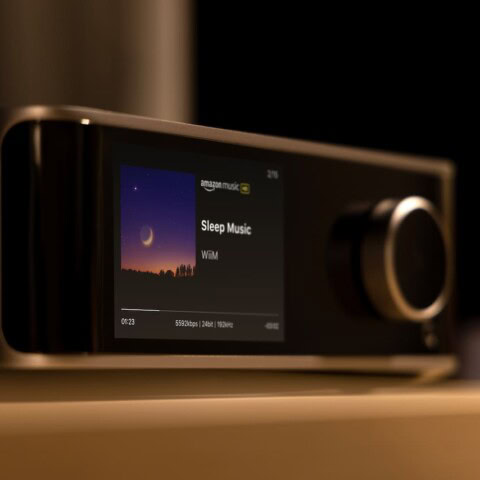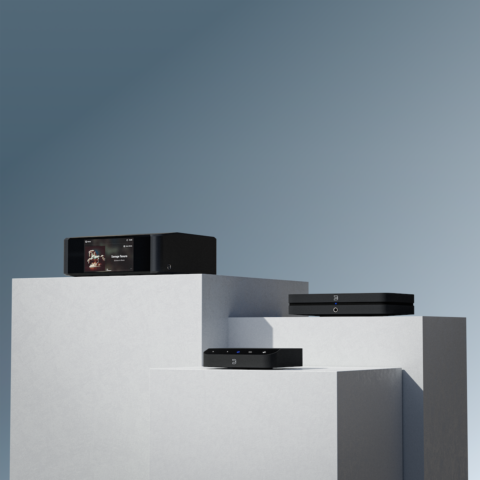$499
4.5 Stars or 1 Star – see conclusion
A brilliant, almost flawless sound dock with a great big caveat attached to it… for now.
WHEN ARCAM’S drDOCK Apple dock arrived, I checked out the price on a local Arcam dealer’s website and was taken aback by the five hundred dollar tag. After all, these days you can buy a simple dock for not much money at all, and all a dock has to do is transfer the signal, right? Then I opened the box and began to get the real picture.
Like Arcam’s rPac (reviewed here), the drDock is a great looking piece of kit with an impressive level of build quality; it’s solidly put together, the cast aluminium chassis feeling as if it was machined from a solid chunk of dense metal. It’s a compact unit that’ll take up only a modicum of desk or rack space but it’s been cleverly designed to dock everything from an iPod Classic to the latest generation of iPad, and there’s not a single fiddly little plastic adapter to be seen. The reassuring weight of the unit and the extra stability of the rubberised base means that the drDock isn’t likely to tip over even with an iPad in place.
Like many modern Apple docks, the drDock takes the Apple device’s digital stream and does the digital to analogue conversion onboard via its built-in high-quality Burr-Brown DAC, thereby bypassing the Apple DAC and feeble output stages. In practice, this should result in a noticeable improvement in audio quality.
 The drDock has an HDMI output to allow video files from Apple devices to be played on an HDMI equipped TV or sent to a compatible receiver. There’s a USB port to allow synching and charging from a computer, although the drDock is also capable of being powered by the supplied wall-wart power supply. Audio connections include the expected RCA analogue outs, but there’s also an SPDIF output to allow the drDock to be connected to an even more capable external DAC if the owner has one in place.A reasonably comprehensive IR remote is included with the drDock, which works well enough, although it’s no replacement for the ease of use and slickness of the touch-screens on Apple devices. The box also contains most of the required cables (the HDMI is MIA though).
The drDock has an HDMI output to allow video files from Apple devices to be played on an HDMI equipped TV or sent to a compatible receiver. There’s a USB port to allow synching and charging from a computer, although the drDock is also capable of being powered by the supplied wall-wart power supply. Audio connections include the expected RCA analogue outs, but there’s also an SPDIF output to allow the drDock to be connected to an even more capable external DAC if the owner has one in place.A reasonably comprehensive IR remote is included with the drDock, which works well enough, although it’s no replacement for the ease of use and slickness of the touch-screens on Apple devices. The box also contains most of the required cables (the HDMI is MIA though).
For owners of Arcam audio or home theatre gear, there’s a control port to allow extensive control from the Arcam system remotes (cable supplied). This gives track information display on the front panels of the Solo and Solo Neo all-in-one units and on-screen displays on Arcam’s AVR receiver range.
The drDock’s remote has a little button that’s meant to disable the charging functionality, which is meant to make for a small but noticeable improvement in audio quality. On the demo unit, this button had no effect on the charging of my iPod or iPhone, and other reviews have indicated the same, so it seems that this function has been deleted from the drDock but not from the remote.
Sound Quality
With a device like this, good build quality and neat features are all very well but to justify that price tag, it had better sound bloody marvelous. So to dig right down to the heart of the matter, I bypassed a speaker based system and hooked the drDock up to the highest resolution equipment I had on hand. Amplification took the shape of my Perreaux SXH2 headphone amplifier with a Nordost Shiva power cord and a 0.5m set of Slinkylinks cryo-treated silver interconnects. The transducers were my trusty and well-used Sennheiser HD650 ‘phones.
I docked my iPod Classic 80Gb loaded with a mix of CD quality and 320kbps tracks and got stuck in. The first song I cued up was ‘Ordinary People’ from Van Morrison’s The Philosopher’s Stone double CD. It didn’t take more than a few beats for me to register that I was hearing one of the best iPod based sources I’d yet heard.
 There were absolutely no sonic weaknesses to focus on; rather I was content just to enjoy a performance that was highly energetic, dynamically charged and absolutely laden with detail. I was able to closely follow every aspect of the vocal track and listen deeply into the way the drums and guitars sounded, picking out the diminutive elements that separate a good performance from a great one. The Sennheisers are a great match with the Perreaux and the combination sounded excellent with the drDock as a source. I kept on listening to this album, which is one of my favourite Van Morrison CDs and at every stage, I felt as if I was plugged into a very good CD player, not an Apple device.
There were absolutely no sonic weaknesses to focus on; rather I was content just to enjoy a performance that was highly energetic, dynamically charged and absolutely laden with detail. I was able to closely follow every aspect of the vocal track and listen deeply into the way the drums and guitars sounded, picking out the diminutive elements that separate a good performance from a great one. The Sennheisers are a great match with the Perreaux and the combination sounded excellent with the drDock as a source. I kept on listening to this album, which is one of my favourite Van Morrison CDs and at every stage, I felt as if I was plugged into a very good CD player, not an Apple device.
Cranking the volume knob round to nearly 4 o’clock with Smashing Pumpkins’ ‘Stand Inside Your Love’ from Rotten Apples was an exercise in self-indulgence, although it had to be a one-off exercise in deference to my long-term ability to continue to hear. The big drum notes had a huge sense of scale and weight, which is mostly down to the Perreaux’s abilities, but the way every part of the song was forensically on display without sounding dryly analytical was what made it special.
The drDock is a very smooth and subtle source, capable of extracting a lot of detail from the Apple drive and presenting it to the amplifier without turning it into a coldly matter of fact presentation. It’s a relatively neutral source, having just enough warmth to ease harsh or compressed music. For example ‘Sail’ from AwolNation’s Megalithic Symphony showed the Arcam/Perreaux/Sennheiser combination at its best. With the volume once again pushed well to the right, the bass notes were prodigiously weighty, yet extremely fast and the all-pervasive harshness at the top was tamed only fractionally, but enough to make the track palatable at those levels. The drDock seemed to have no trouble making even 128kbps tracks sound good despite the revealing nature of the headphone system, although the higher bitrates were noticeably better sounding as expected. Still, it’s nice to know that your cherished 128k Napster downloads from 2000 won’t sound so lousy that you’re forced to lunge for the remote.
The drDock didn’t put out a massive signal because even with the Perreaux on high-gain, I needed to run the volume control at between 1 and 3 o’clock to get some real grunt and to motivate the headphone drivers, but this proved no real hassle and most hi-fi systems will have no issue at all.
Video Quality
While video isn’t exactly a major priority of mine, that HDMI port round the back of the drDock means that it’s simple to get the videos on your Apple device to your big screen. What’s more, you can even feed the digital audio stream to your receiver using the SPDIF output if you want to get your surround sound system involved.
Because I was so focused on the sound quality, I didn’t test the video beyond hooking up an older iPhone, which actually looked pretty good streaming YouTube videos on a 42” TV. However, the drDock will output an Apple device’s native resolution to the TV and the TV will then rescale it as needed. This bodes well for owners of devices with retina displays, especially the iPad 3.
The bugbear lurking behind the drDock and all similar devices has nothing to do with the units themselves but rather with Apple’s change to the new Lightning connector on the iPhone 5. This connector is also used on the new iPod Touch and iPod Nano and one can logically assume that the next iPad will have it too.
So your next Apple device just isn’t going to function on the drDock. Nor is there any guarantee that a Lightning to 30-pin adapter will do its advertised job given that Apple can’t make any assurances that every device will function properly with an adapter. It seems that the adaptors will support analogue audio out, not digital out and apparently not video out either. Even if the adaptor did work perfectly in terms of signal pass-through, it’s hard to picture an iPad precariously docked in a drDock on top of an adapter.
Unless you’re 100% convinced that you won’t be upgrading to a Lightning equipped Apple device in the next few years, it’s probably best to forget about this wobbly adapter scenario, which means that the best plan of action is to wait for the revised drDock that’ll surely be released in the near future. Even if you’re convinced that your 30-pin equipped Apple gadgets are what you’ll be using for a while, what about friends and family? Will they be upgrading? What if you accidentally smash your iPhone 4S and your insurers happily buy you an iPhone 5 to replace it? Then your $499 dock is basically a really cool looking, heavy paperweight.
So in effect, what we have here is a superb product. It’s beautifully designed, a pleasure to use and it sounds fabulous to boot. A couple of months ago, this review would have been totally upbeat and complimentary – there’s no doubt that the drDock is very close to garnering a five star ranking, held back only by that lofty price tag. Unfortunately, it’s been badly hamstrung in the medium to long term by circumstances totally beyond the manufacturer’s control.
Given that Arcam has an excellent product here, I’d be very surprised if a new version wasn’t forthcoming very soon, in which case, the original rating and extremely positive review would apply to the Lightning equipped model when it arrives (assuming the only major change is the connector). ASHLEY KRAMER


















I can’t believe they have come out with a dock connector device now. At my day job we have been running out dock connector stuff for the last 3-4 months as the changing connector has been no secret.
That dock has been out for a while but this is the first chance we’ve had to listen to it. I’d assume a new version with a Lightning connector won’t be far away.